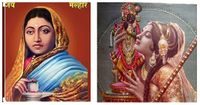Sarupa-vigraha
From Hindupedia, the Hindu Encyclopedia
By Swami Harshananda
Sarupa-vigraha literally means ‘an icon with form’.
In ritualistic worship vigrahas or icons are used extensively. These may be sarupa[1] or arupa.[2] It can be classified as follows:
- Sarupa-vigraha - It has a definite form, the form of the deity to whom worship is offered. It may be anthropomorphic or otherwise. Excessive limbs like four hands or unnatural features like half-animal body are often seen in them to denote their supernatural status and power.
- Arupa-vigrahas - These are the śivaliṅgas, śālagrāmas, yantras, cakras and stones of irregular shapes.
References[edit]
- The Concise Encyclopedia of Hinduism, Swami Harshananda, Ram Krishna Math, Bangalore

